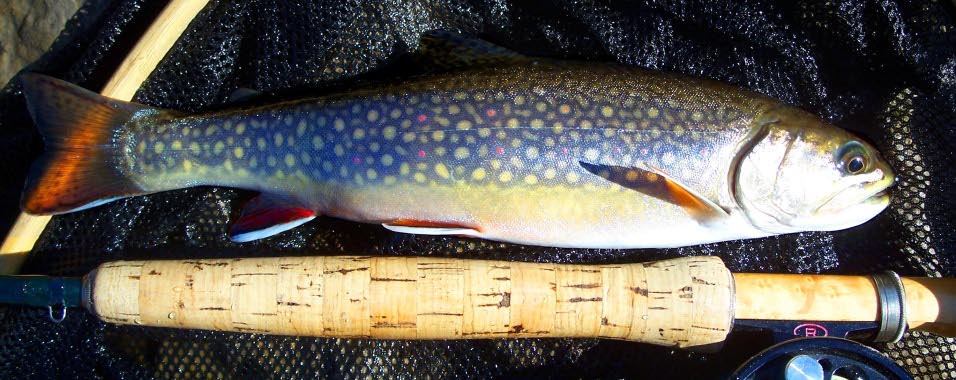
Brook Trout
The brook trout, or brookie, has been called the most beautiful fish in the world. Each one is a unique work of art. Their greenish back is packed with squiggly black markings. Fins are often bright red, with wide white leading edges that look almost artificial. Their sides are spotted with red and purple, and their bellies are white and orange. Brook trout are the smallest of our local salmonids, seldom reaching a pound in weight. But long ago, dozens of strains of "Coaster" brook trout thrived in lake superior. These fish were migratory, like salmon, and weighed in at several pounds average. Sadly, the coasters were exterminated from almost all US waters and today very few, if any, still survive.
Species:
The Brook Trout, as we know it today, is generally a stream-dweller. They tolerate only the most clean, cold, highly oxygenated waters. They are the most demanding of the midwestern trout with regard to water quality. In fact, brook trout have been outcompeted and wiped out by invasive exotics like the brown and rainbow trout, so that good brookie streams are difficult to find in this day and age. Grizzled brookie veterans are a tight-lipped bunch, but stories are told of remote beaver ponds, teeming with fat fourteen-inchers. Beaver ponds can create a brook trout haven in a stream otherwise too shallow and infertile to support trout of any size. But even the tiniest of streams can be a perfect home for the brook trout; they are slippery and even in shallow water can often elude the most clever mink or otter. To hold a population of brookies, a stream two inches deep and a foot wide is sufficient, as long as a few deeper pockets or undercut banks exist.
Brook trout, being one of the most beautiful fish in the world, and also perhaps the tastiest, are not particularly smart. Brookies are quite ravenous and do not usually exhibit the high selectivity often seen in other trouts of the stream. While live bait and small spinning lures will work wonders on brook trout, flies are even deadlier. Dry attractors like the Royal Wulff, the legendary Pass Lake, the Elkhair Caddis, and the Stimulator will often provoke brookies into savage aerial attacks. Scuds, nymphs, and streamers are also very effective. The McGinty is a classic wet fly that has been catching brookies for 100 years. Brook trout should be conserved whenever possible, and only kept when the local population is very healthy.
Sometimes, a beaver pond can spoil a trout stream by warming the water and blocking migration. However, in a stream that might not otherwise be a good trout stream, beaver ponds can create a fertile, deep haven that allows brook trout to fluorish. Deep in the northwoods, beaver ponds exist that are hundreds of years old. Brook trout of impressive size may be found in these remote, mosquito-infested havens.




 Powered
Powered